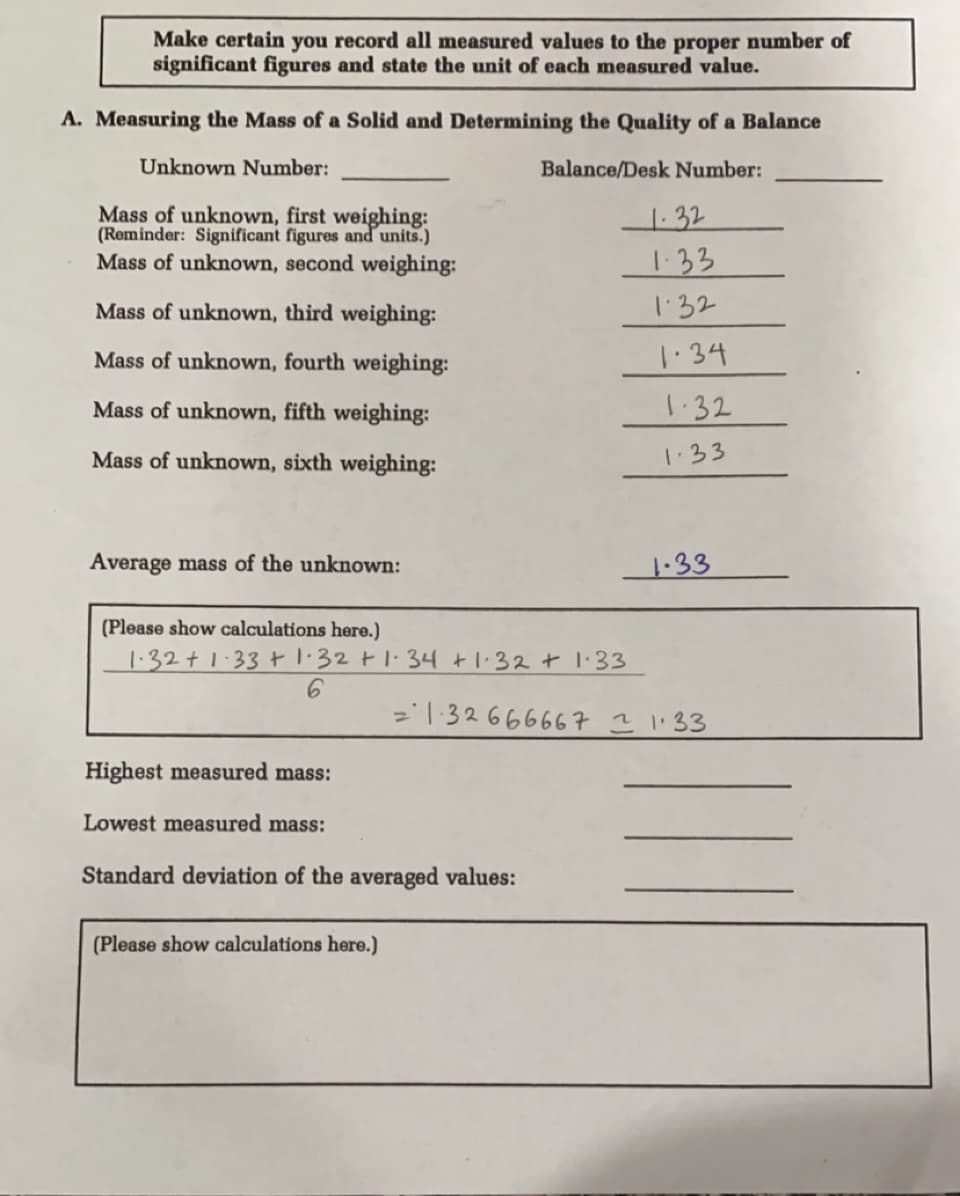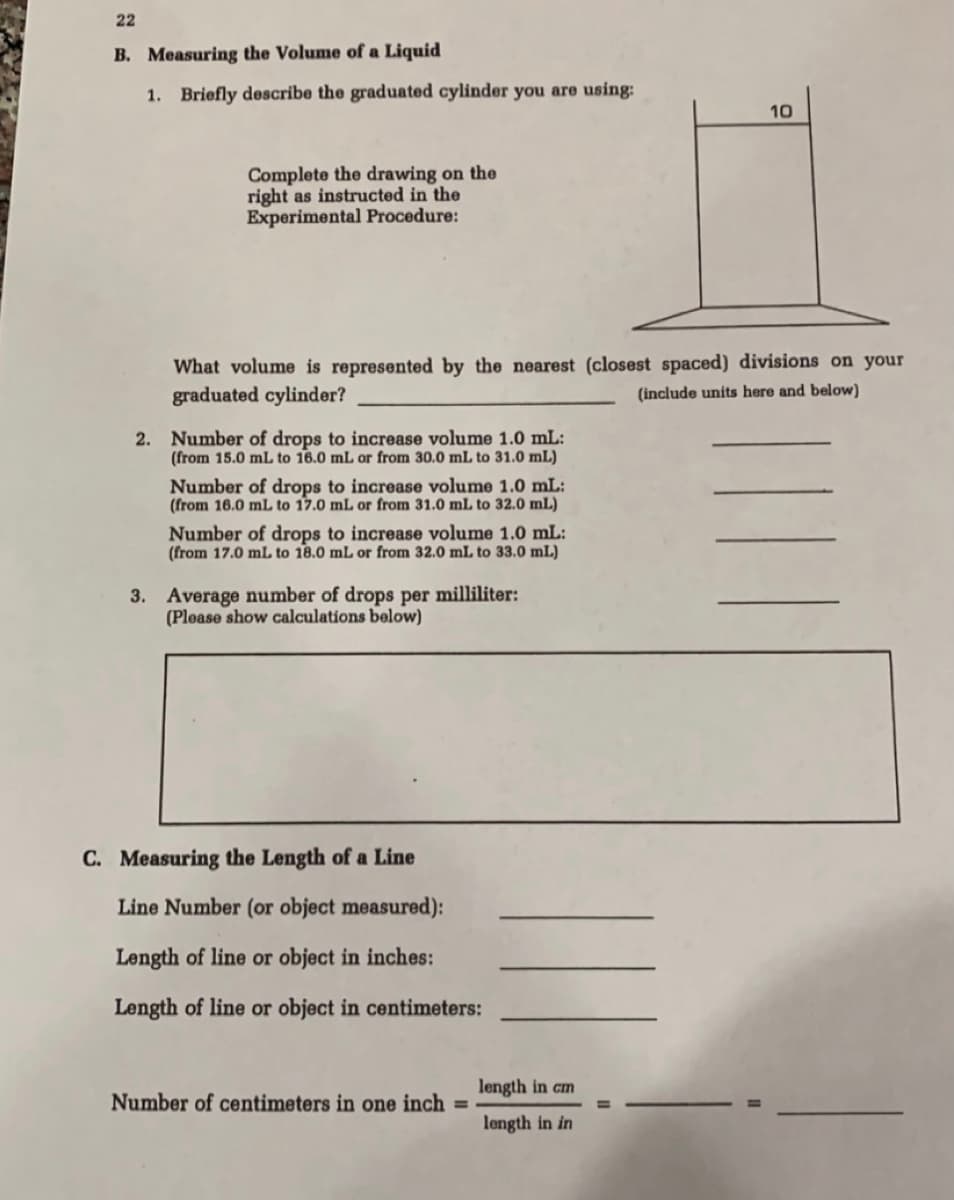A. Measuring the Mass of a Solid and Determining the Quality of a Balance Unknown Number: Balance/Desk Number: Mass of unknown, first weighing: (Reminder: Significant figures and units.) Mass of unknown, second weighing: 1.32 1.33 Mass of unknown, third weighing: 132 Mass of unknown, fourth weighing: 1.34 Mass of unknown, fifth weighing: 1.32 Mass of unknown, sixth weighing: 1.33 Average mass of the unknown: 1-33 (Please show calculations here.) 1.32+1.33 +1:32 +1.34 +132+ 1.33 2132 666667 I 1.33 Highest measured mass: Lowest measured mass: Standard deviation of the averaged values: (Please show calculations here.)
A. Measuring the Mass of a Solid and Determining the Quality of a Balance Unknown Number: Balance/Desk Number: Mass of unknown, first weighing: (Reminder: Significant figures and units.) Mass of unknown, second weighing: 1.32 1.33 Mass of unknown, third weighing: 132 Mass of unknown, fourth weighing: 1.34 Mass of unknown, fifth weighing: 1.32 Mass of unknown, sixth weighing: 1.33 Average mass of the unknown: 1-33 (Please show calculations here.) 1.32+1.33 +1:32 +1.34 +132+ 1.33 2132 666667 I 1.33 Highest measured mass: Lowest measured mass: Standard deviation of the averaged values: (Please show calculations here.)
Chapter1: Excel Basics
Section: Chapter Questions
Problem 2P
Related questions
Question

Transcribed Image Text:Make certain you record all measured values to the proper number of
significant figures and state the unit of each measured value.
A. Measuring the Mass of a Solid and Determining the Quality of a Balance
Unknown Number:
Balance/Desk Number:
Mass of unknown, first weighing:
(Reminder: Significant figures and units.)
Mass of unknown, second weighing:
1.32
1.33
Mass of unknown, third weighing:
132
Mass of unknown, fourth weighing:
1.34
Mass of unknown, fifth weighing:
1.32
Mass of unknown, sixth weighing:
1.33
Average mass of the unknown:
1.33
(Please show calculations here.)
1.32+1:33+ 1:32 t1:34 +1:32 + 1.33
='132666667 ?1'33
Highest measured mass:
Lowest measured mass:
Stand
devi
of the averaged values:
(Please show calculations here.)

Transcribed Image Text:22
B. Measuring the Volume of a Liquid
1. Briefly describe the graduated cylinder you are using:
10
Complete the drawing on the
right as instructed in the
Experimental Procedure:
What volume is represented by the nearest (closest spaced) divisions on your
graduated cylinder?
(include units here and below)
2. Number of drops to increase volume 1.0 mL:
(from 15.0 mL to 16.0 mL or from 30.0 mL to 31.0 mL)
Number of drops to increase volume 1.0 mL:
(from 16.0 mL to 17.0 mL or from 31.0 mL to 32.0 mL)
Number of drops to increase volume 1.0 mL:
(from 17.0 mL to 18.0 mL or from 32.0 mL to 33.0 mL)
3. Average number of drops per milliliter:
(Please show calculations below)
C. Measuring the Length of a Line
Line Number (or object measured):
Length of line or object in inches:
Length of line or object in centimeters:
length in cm
Number of centimeters in one inch =
length in in
Expert Solution
This question has been solved!
Explore an expertly crafted, step-by-step solution for a thorough understanding of key concepts.
This is a popular solution!
Trending now
This is a popular solution!
Step by step
Solved in 2 steps with 2 images

Knowledge Booster
Learn more about
Need a deep-dive on the concept behind this application? Look no further. Learn more about this topic, chemistry and related others by exploring similar questions and additional content below.Recommended textbooks for you


Chemistry by OpenStax (2015-05-04)
Chemistry
ISBN:
9781938168390
Author:
Klaus Theopold, Richard H Langley, Paul Flowers, William R. Robinson, Mark Blaser
Publisher:
OpenStax



Chemistry by OpenStax (2015-05-04)
Chemistry
ISBN:
9781938168390
Author:
Klaus Theopold, Richard H Langley, Paul Flowers, William R. Robinson, Mark Blaser
Publisher:
OpenStax
